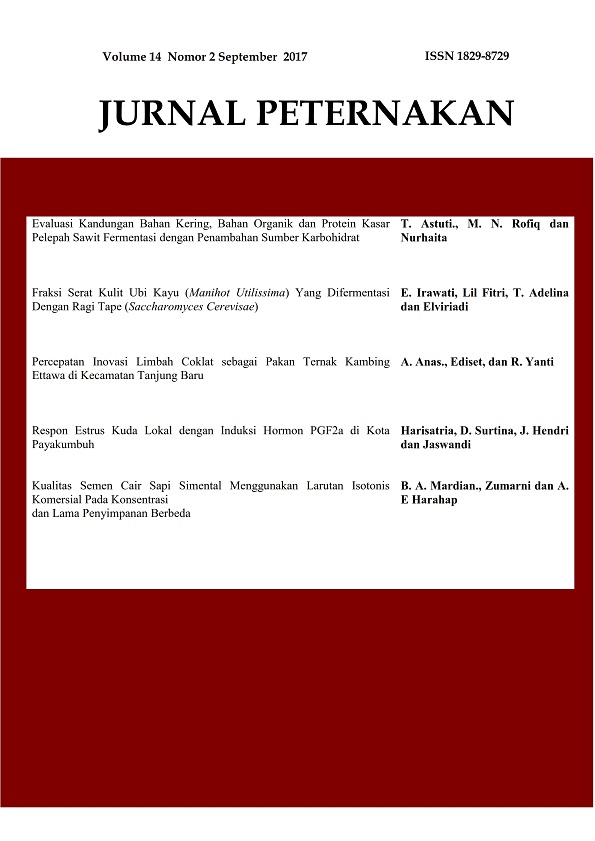EVALUASI KANDUNGAN BAHAN KERING, BAHAN ORGANIK DAN PROTEIN KASAR PELEPAH SAWIT FERMENTASI DENGAN PENAMBAHAN SUMBER KARBOHIDRAT
DOI:
https://doi.org/10.24014/jupet.v14i2.4247Keywords:
palm oil fronds, fermentation, carbohydrate sourceAbstract
This research was aimed to evaluate the content of dry matter, organic matter and crude protein of palm oil fronds as an alternative feed substitution of native grass, which was enhanced through fermentation biotechnological innovation with the addition of carbohydrate soluble. Fermentation palm oil frond done using local microorganisms resources rumen content and
Lactobacillus. The experimental design used was factorial on complete randomized design 2x3 with 3 replication each treatment. Factor A were the source of inoculums fermentation, A1=. lactobacillus, A2= local microorganisms resources rumen content. Factor B were the source of soluble carbohydrates where B1 = without a carbohydrates, rice B2 = e bran, B3 = tapioca starch. Parameters measured were content of dry matter, organic matter and crude protein of palm oil fronds. The results of this research showed that no interaction effect between the source of microorganisms with carbohydrates, and the treatment had no effect (P > 0.05) on dry matter content. No effect Factor A for all parameters while the factors B Influential were significantly (P < 0.01) on the content of organic matter and crude protein. The highest crude protein content in the fermented palm oil fronds with a source of carbohydrates from rice bran (6.55%)
References
AOAC, 1995. Official Methods of Analysis of The Association Agricultural Chemists. 14 th
Ed., Washington DC
Astuti.T, Yurni. S. Amir, Gusni Yelni, and Isyaturriyadhah. 2014. The Result of
Biotechnology by Local Microorganisms to Banana Peel on Rumen Fluid Characteristics as Ruminant Feed. Journal of Advanced Agricultural Technologies. Vol. 1 (1): 28 – 31
Astuti, T., Y. Amir, Irdawatiand U. Santoso. 2016. Nutritional improvement of palm oil
fronds for ruminant feedstuffs using a local biotechnological approach. Pak. J. Nutr.,
:450–454.
BPS, 2014. Staistik perkebunan Indonesia 2013-2015 kelapa sawit. , (December 2014).
Luh, B., 1991. Rice Utilization Vol II. Van Nostrand Reinhold, New York
Richana, N dan Sunarti, T.C., 2004. Karakterisasi Sifat Fisikokimia Tepung Umbi dan
Tepung Pati dari Umbi Ganyong, Suweg, Ubi Kelapa, dan Gembili. Jurnal
Pascapanen Vol. 1. No. 1. Hal: 29-37.
Simanihuruk K, Junjungan Dan Andi Tarigan. 2007. Pemanfaatan pelepah kelapa sawit
sebagai pakan basal kambing kacang fase pertumbuhan. Proseding Seminar Nasional Teknologi Peternakan dan Veteriner 2007. Hal 417-425
Wajizah, S., Samadi., Usman, Y., Mariana, E., 2015. Evaluasi Nilai Nutrisi dan Kecernaan In
Vitro Pelepah Kelapa Sawit (Oil Palm Fronds) yang Difermentasi Menggunakan Aspergillus niger dengan Penambahan Sumber Karbohidrat yang Berbeda. Agripet : Vol (15) No. 1 : 13-19
Zakaria. Y, Cut Intan Novita1 dan Samadi. 2013. Efectivitas fermentasi dengan sumber
substrat yang berbeda terhadap kualitas jerami padi. Agripet : Vol (13) No. 1: 22-25
Zumael, Z. 2009. The Nutrient Enrichment of Biological Processing. Agricmed, Warsaw
Downloads
Published
Issue
Section
License
The Authors submitting a manuscript do so on the understanding that if accepted for publication, copyright of the article shall be assigned to Jurnal Peternakan and published by Fakultas Pertanian dan Peternakan Universitas Islam Negeri Sultan Syarif Kasim Riau as publisher of the journal.
Authors who publish with this journal agree to the following terms:
Authors automatically transfer the copyright to the journal and grant the journal right of first publication with the work simultaneously licensed under a Creative Commons (CC BY) that allows others to share the work with an acknowledgement of the work's authorship and initial publication in this journal.
Authors are able to enter into separate permission for non-exclusive distribution of the journal's published version of the work (e.g., post it to an institutional repository or publish it in a book), with an acknowledgement of its initial publication in this journal.
Authors are permitted and encouraged to post their work online (e.g., in institutional repositories or on their website) prior to and during the submission process, as it can lead to productive exchanges, as well as earlier and greater citation of published work (See The Effect of Open Access).

